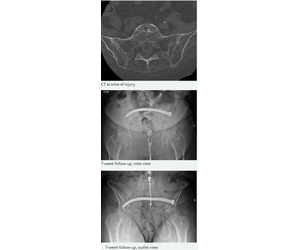

Sacral Insufficiency Fractures in a Geriatric Patient Treatment with the Curvafix IM System - Case Study
CASE PRESENTATION
A 70-year-old female had a ground-level fall. Computed tomography imaging showed sacral insufficiency fractures in the left ala. No lumbar fracture was observed. Conservative treatment was initiated but the patient was referred 6 weeks post injury, unable to mobilize with a walker and needing a wheelchair. There was no anterior pelvic pain with palpation or weight bearing, but disabling left posterior pain with any weight bearing, and pain at rest and when rolling in bed. Prior to the injury, the patient was a community ambulator; typically with a cane and occasionally with a walker. The patient had osteoporosis, hepatic failure with
cirrhosis, and moderate obesity.
POSTERIOR PELVIC FIXATION
A transiliac-transsacral CurvaFix® IM Implant was placed in an outpatient procedure. At completion, the implant was appropriately positioned with a good curve. The implant was well contained within the sacrum, and well between the L5-S1 endplate.
The patient was discharged the same day and immediately felt different and more stable after surgery. The patient felt significant pain relief and was able to ambulate with a walker.
FOLLOW-UP
At 2 weeks, the patient was back to pre-fall baseline, ambulating primarily with a cane and occasional use of a walker, and able to sleep comfortably..
At 7 weeks, there was no change in the position or curve of the implant, and no signs of loosening or lucency


KEY POINTS
- Surprisingly good purchase in the contralateral ilium as the screw compressed the back of the pelvis, which can be difficult with a straight screw in older osteoporotic patients.
- Outpatient procedure and immediate pain relief felt bythe patient, along with immediate ambulation with a walker.
